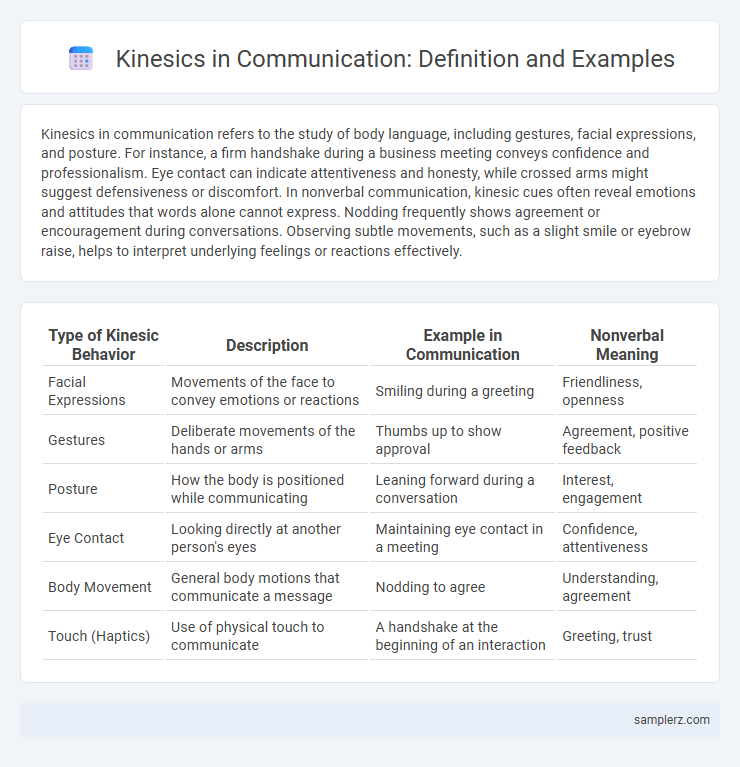Kinesics in communication refers to the study of body language, including gestures, facial expressions, and posture. For instance, a firm handshake during a business meeting conveys confidence and professionalism. Eye contact can indicate attentiveness and honesty, while crossed arms might suggest defensiveness or discomfort. In nonverbal communication, kinesic cues often reveal emotions and attitudes that words alone cannot express. Nodding frequently shows agreement or encouragement during conversations. Observing subtle movements, such as a slight smile or eyebrow raise, helps to interpret underlying feelings or reactions effectively.
Table of Comparison
| Type of Kinesic Behavior | Description | Example in Communication | Nonverbal Meaning |
|---|---|---|---|
| Facial Expressions | Movements of the face to convey emotions or reactions | Smiling during a greeting | Friendliness, openness |
| Gestures | Deliberate movements of the hands or arms | Thumbs up to show approval | Agreement, positive feedback |
| Posture | How the body is positioned while communicating | Leaning forward during a conversation | Interest, engagement |
| Eye Contact | Looking directly at another person's eyes | Maintaining eye contact in a meeting | Confidence, attentiveness |
| Body Movement | General body motions that communicate a message | Nodding to agree | Understanding, agreement |
| Touch (Haptics) | Use of physical touch to communicate | A handshake at the beginning of an interaction | Greeting, trust |
Understanding Kinesics in Communication
Kinesics in communication refers to the interpretation of body language, such as facial expressions, gestures, posture, and eye contact, which convey emotions and intentions beyond spoken words. Understanding kinesics helps decode nonverbal cues like a smile indicating friendliness or crossed arms signaling defensiveness, enhancing message accuracy. Mastery of kinesic signals is essential for effective interpersonal communication and conflict resolution.
Types of Kinesic Behaviors
Kinesic behaviors in communication include facial expressions, gestures, posture, and eye contact, each conveying distinct messages without spoken words. Facial expressions like frowning or smiling reveal emotions, while gestures such as waving or pointing emphasize speech content. Posture reflects confidence or openness, and eye contact regulates interaction and signals attention or interest.
Facial Expressions as Kinesic Cues
Facial expressions serve as vital kinesic cues in communication by conveying emotions such as happiness, anger, or confusion without spoken words. For instance, a smile can indicate friendliness or approval, while furrowed brows often signal concern or disagreement. These nonverbal signals enhance message clarity and emotional understanding during interpersonal interactions.
Eye Contact and Its Communicative Role
Eye contact serves as a powerful kinesic cue in communication, signaling attention, interest, and confidence during interactions. Maintaining appropriate eye contact fosters trust and facilitates emotional connection between speakers and listeners. Conversely, avoiding eye contact can indicate discomfort, disinterest, or evasiveness, impacting the overall effectiveness of the communicative exchange.
Gestures: Expressing Meaning Without Words
Gestures play a crucial role in kinesic communication by conveying messages without spoken language, such as a thumbs-up signaling approval or a wave indicating greeting. Hand movements like pointing can direct attention or emphasize a statement, while nodding often signifies agreement or understanding. These nonverbal cues enhance interaction by supplementing or replacing verbal communication, enabling clearer expression of intent and emotion.
Posture and Body Orientation in Conversations
Posture and body orientation play crucial roles in kinesic communication, revealing attitudes and engagement levels during conversations. An open posture, with shoulders relaxed and facing the speaker, signals attentiveness and openness, while crossed arms or turning away can indicate defensiveness or disinterest. Maintaining appropriate body orientation fosters effective interaction by enhancing rapport and nonverbal understanding between participants.
The Impact of Touch in Kinesic Communication
Touch in kinesic communication plays a crucial role in conveying emotions, reinforcing messages, and establishing trust between individuals. For example, a gentle pat on the back can indicate support or encouragement, while a firm handshake often signifies confidence and professionalism. Research shows that tactile interactions activate sensory pathways in the brain, enhancing emotional connections and improving interpersonal communication effectiveness.
Cultural Variations in Kinesic Signals
Kinesic communication, such as gestures and facial expressions, varies significantly across cultures, influencing how messages are interpreted during interactions. In some Asian cultures, for example, direct eye contact may be seen as disrespectful or confrontational, while in Western cultures, it is often associated with confidence and honesty. Understanding these cultural variations in kinesic signals is crucial for effective cross-cultural communication and avoiding misunderstandings.
Kinesics in Digital and Virtual Communication
Kinesics in digital and virtual communication includes the use of facial expressions, gestures, and body language detected through video calls and virtual meeting platforms, enhancing nonverbal cues despite physical distance. Emoticons, emojis, and GIFs serve as digital proxies for traditional kinesic signals, conveying emotions and reactions efficiently in text-based interactions. Analyzing user posture and eye contact via webcam enables more authentic engagement and interpretation of intent during remote communication.
Enhancing Communication Skills Through Kinesics
Kinesics, the study of body language, greatly enhances communication by revealing unspoken emotions and intentions through gestures, facial expressions, and posture. Mastering kinesic cues improves interpersonal understanding, allowing individuals to respond appropriately and build stronger connections. Effective use of kinesics reduces misunderstandings and fosters clearer, more empathetic communication in both personal and professional settings.

example of kinesic in communication Infographic
 samplerz.com
samplerz.com